New Jersey Endangered Species
TNC protected lands and waters provide a haven for some of New Jersey's most endangered animals and plants.
New Jersey, the most densely-populated state in the country, is home to more than 700 endangered species. One of the biggest threats to their survival is loss of quality habitat. For more than 60 years, we’ve been working in New Jersey to protect the lands and waters all life depends on. Many of our state's most endangered species rely on these protected lands to survive.

Breaking News
In December of 2024 the US Fish and Wildlife Service moved to to protect the iconic monarch butterfly and proposed listing it as threatened with extinction under the Endangered Species Act. The loss of pollinators like the monarch could have far-reaching consequences for ecosystems and the people who rely on them. Without immediate action, officials warn that the monarch could vanish from the continent for good before the end of the century.
Animals
Despite being densely populated and a very small state, New Jersey is home to over 800 animal species. For various reasons like habitat loss and development, over 80 of New Jersey's animal species have been listed as endangered. Here, we'll get to know seven of New Jersey's most at risk animals.

Piping Plover
Status: Federally Endangered
These small shorebirds make their way to barrier islands and beaches in New Jersey each year for their breeding season. Starting in April, the female will lay between three to four eggs, which both parents will incubate for about 27 days.
Piping plovers were common during the 1880s, but became nearly locally extinct during the 1890s on from market hunting and egg collecting. They were afforded protection by the Migratory Bird Treaty Act of 1918, and for a while the population numbers began to recover. Unfortunately, during the late 1940s, population numbers began to decline again. A number of threats contribute to their declining population sizes, such as predation from red fox, raccoons and gulls, loss of habitat from development, flooding from storm surges, and disturbance from beach activities like beach raking and dog walking.
In an effort to protect their breeding grounds at our South Cape May Meadows preserve, we have installed two nesting enclosures on our protected beach to help minimize disturbance. To attract the plovers to nest here, we have installed call boxes that send out piping plover calls and placed plover decoys sitting on simulated nests in the enclosed areas. Although piping plovers haven’t nested on our South Cape May Meadows beach for several years due to disturbance and changing beach habitat, we are hopeful that our efforts will provide them with safe and successful nesting habitat.



Bog Turtle
Status: Federally Endangered
This small, dark turtle has an orange marking behind the ear membrane on both sides of its head. Bog turtles rely on wetland habitats for foraging, nesting, basking and hibernating. They eat seeds, insects, worms, snails, carrion and berries, amongst other things. They are most active in the spring, when they emerge from hibernation to breed.
Declining population sizes due to habitat loss and collection for illegal wildlife trade landed the bog turtle on the endangered species list for New Jersey in 1974 and then the list of federally threatened species in 1997. Bog turtle habitat is being lost due to development, pollution, and invasive species. By preserving areas that are optimal for bog turtles, such as our Johnsonburg Swamp Preserve, we are providing suitable habitat that will never face the threat of development.
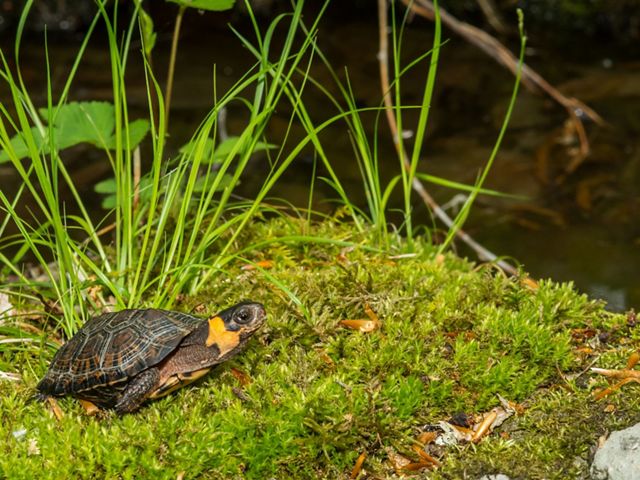

Stay connected for the latest news from nature.
Get global conservation stories, news and local opportunities near you. Check out a sample Nature News email.
Least Tern
Status: State Endangered
Least terns are small, colonial shorebirds that migrate to New Jersey beaches each year for their nesting season. They were once very common along New Jersey coasts, but egg collecting and hunting in the early 1900s caused their population to plummet. The Migratory Bird Treaty Act of 1918 helped their population rebound. Unfortunately, coastal development that took off in the 1940s and the increased use of beaches for recreation has led to another decline.
Our South Cape May Meadows Preserve boasts a mile of protected beach where least terns have historically attempted nesting. In addition to helping protect nesting piping plovers, we also aim to provide safe and pristine nesting habitat for least terns. We are happy to report that in 2019 and 2020, after about four to five years of having no successful fledges, we had eight tern chicks fledge both years.
Little Strikers
If you’ve ever gone to a New Jersey beach and got dive bombed by a shore bird…it was probably a least tern. Although small, these feisty little birds are not afraid to defend their nesting grounds. When an intruder enters their nesting area, they will dive bomb, and often defecate on them. This has earned them the nickname “Little Striker”.
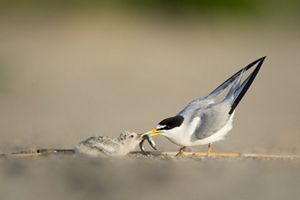
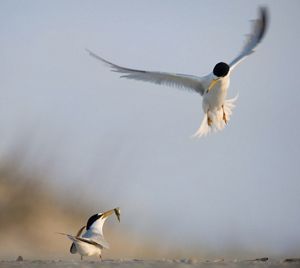
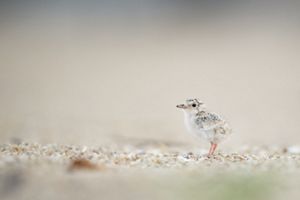
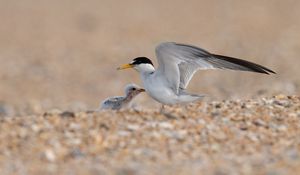
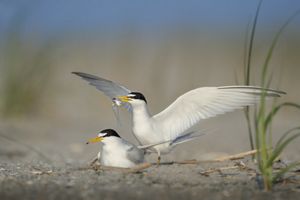

Adult Least Tern Feeding Chick: Both parents take part in feeding their chicks. Chicks will stay with their parents for an additional 2-3 months after learning how to fly. © Shutterstock: Ray Hennessy

Least Tern Mating Display: Least terns are small shorebirds that have a unique courtship ritual including various postures & vocalizations, as well as feedings. © Shutterstock: Ray Hennessy

Lone Least Tern Chick: Least tern chicks leave the nest a few days after hatching. In about 19-20 days, they will take their first flight. © Shutterstock: Ray Hennessy

Least tern shelters chick: Adult least terns have a unique defense mechanism. When they feel threatened, they will dive bomb & often defecate on intruders. © Shutterstock: Harry Collins

Least Terns in Courtship: If the female least tern accepts the fish, she is accepting the male least tern as a mate. © Shutterstock: Ray Hennessy

Bobcat
Status: State Endangered
Once nearly extinct in New Jersey, bobcats are slowly growing in numbers in the Northern part of the state, but they still have a long way to go. Massive deforestation and development led bobcats to be locally extinct in New Jersey by 1970. Preserving large areas of their habitat is crucial to their survival, as bobcats have one of the largest ranges of any animals in the state, roaming an average of seven miles per day. They prey on rabbits, mice, squirrels, songbirds and sometimes small deer. Bobcats only eat about three pounds of meat at a time, so if they find something larger than this, they carry it with them to a safe spot, cover it up, and return later to feed again.
We are working to protect critical habitat for these precious felines in Northwestern New Jersey, in an area known as Bobcat Alley. This 32,000-acre forested corridor is prime habitat for bobcats. It spans from the Highlands to the Appalachian mountain ranges. So far it is about one-third protected. TNC and partners have a goal of protecting an additional one-third of the land by 2027.


American Bittern
Status: State Endangered (Breeding Population)
American bitterns are medium-sized wading birds. They feed on fish and other small aquatic species they find within marshes and along creek shorelines. Their camouflaged feathers allow them to stalk their prey before striking. During breeding season, they live in wetland areas, where their nests can typically be found near shallow water in thick vegetation. Most American bitterns migrate south in the fall, but some remain in New Jersey to winter.


One of the largest threats in New Jersey to American Bitterns is habitat loss. Wetlands that were critical breeding grounds were destroyed, causing their populations to decline. Protected lands such as our South Cape May Meadows, Garrett Family and Maurice River Bluffs Preserves provide pristine breeding habitat for this species.

Eastern Tiger Salamander
Status: State Endangered
The eastern tiger salamander is the largest salamander in New Jersey. It is dull black and brown, with a blotchy pale-yellow underside. It has a blunt, rounded snout that it uses to burrow underground where it eats spiders, insects, and worms.
In New Jersey, eastern tiger salamanders are limited to wetlands and ponds in Cape May County, and Southern Atlantic and Cumberland Counties. They migrate to their breeding ponds in late winter or early spring, where females will lay eggs attached to twigs or rooted vegetation in ponds. After hatching, the larvae transform into juveniles in about 75-115 days. From the ponds, the juveniles will head to underground burrows and tunnels, where they will spend most of their lives.
New Jersey populations of eastern tiger salamanders have been declining due to habitat loss and pollution of their breeding ponds. Illegal dumping, as well as the filling of these ponds has destroyed many of their breeding sites. Pollution from insecticides and fertilizers can kill their eggs and larvae, or cause their breeding ponds to be uninhabitable. Many have turned to man-made pools, such as old gravel pits and farm ponds. Habitat loss caused by development of upland forest is another major threat to their survival.
The protected wetlands and forests of our Lizard Tail, Maurice River Bluffs and Eldora Preserves provide these salamanders with optimal breeding habitat. When visiting these preserves, always remember to stay on marked trails to minimize disturbance, as salamanders could be burrowing!


Southern Gray Treefrog (Copes Gray Treefrog)
Status: State Endangered
The southern gray treefrog, also known as Cope’s gray treefrog, is limited to just four counties in New Jersey: Cape May, Cumberland, Ocean and Atlantic Counties. They spend the majority of their time high up in trees. During breeding season, they make their way to ponds and wetlands to breed on branches hanging above the water. Southern gray treefrogs rely on small freshwater ponds that contain water long enough for their tadpoles to reach metamorphosis but dry up by end of summer to prevent the establishment of predatory fish.
In 1979, the southern gray treefrog was listed as an endangered species in New Jersey. Development of forests, illegal filling of vernal ponds and destruction of wetlands all play major roles reducing this frog's habitat. Although current regulations protect wetlands, many of the upland forest habitats also required by the Southern gray treefrog remain vulnerable.
Plants
New Jersey's geological diversity supports a wide variety of native plant species. While there are many laws protecting threatened and endangered animals, that is not the case for plants. New Jersey has over 2,000 native plant species and almost 700 of them are considered rare.
Hammond's Yellow Spring Beauty
Status: Globally Endangered
Hammond’s yellow spring beauty is an extremely rare wildflower that is only found in a few secluded areas of Northwestern New Jersey. The flower is smaller than a dime and blooms in May in a rare inland acidic seep.


The flower was discovered over 50 years ago by a local naturalist named Emilie K. Hammond. It's special habitat lies in one of our protected areas known as the Arctic Meadows Preserve. This 100-acre preserve is located in the foothills of the Kittatinny Mountain Range. Unlike most of our preserves, this one is not open to the public.

Sensitive Joint Vetch
Status: State Endangered
New Jersey is one of only four states where sensitive joint vetch still remains. It is listed as state endangered and federally threatened. This species in the legume family has yellow, irregular flowers and leaves that fold slightly when touched, hence the name. Sensitive joint vetch grows in intertidal zones of coastal marshes. It prefers the lower edge of marshes where the soil may be mucky or sandy. This species thrives in areas where there is less plant competition.

Historically, sensitive joint vetch was found in Maryland, New Jersey, Virginia, North Carolina, Delaware and Pennsylvania. Development and filling and dreding of marshes have led to its local extinction in Delaware and Pennsylvania. Other threats to its success are recreational acivities, pollution, sedimentation and introduced insect pests.

Lesser Bladderwort
Status: State Endangered
Lesser bladderwort is only found in a few locations in New Jersey, and our Johnsonburg Swamp Preserve is one of them. It is a carnivorous plants that uses small bladder-like traps to capture and digest prey. When tiny creatures like water fleas or microscopic worms touch the sensitive hairs near the opening of the trap, the valves open and cause water to flow quickly inside, trapping the prey. The trap then snaps shut, sometimes as quickly as 0.0002 seconds! The prey is slowly dissoloved, and the nutrients are absorbed by the plant.
Lesser bladderwort is a rootless plant with thin underwater stems. It prefers the shallow waters of fens, wetlands and ponds. Habitat loss and changes in water quality are two of the main threats to this plant in New Jersey.

Swamp Pink
Status: State Endangered
New Jersey is a stronghold for the endangered swamp pink. In fact, over half of the known populations are found in New Jersey. Swamp pink occurs in wetlands, spring seepage areas, headwater wetlands and forested wetlands. It can only occur in areas with stable water tables with a water line that rests just below its leaves. The evergreen leaves can be seen year-round and flowering occurs between March and May.

Historically, this species was found from New York all of the way down to Georgia, but its range is much more limited now. Some of the major threats to its success are development, direct destruction of wetlands and changes in groundwater hydrology. Pesticides and fertilizer use, construction and other human activities lead to pollution that disturbs this plant's habitat. Conserving and restoring wetlands is critical to conservation and recovery of this species.
Support Our Work in New Jersey
Help us protect these lands and waters so that generations to come of people and wildlife can enjoy them and benefit from the clean water, air and habitats.
